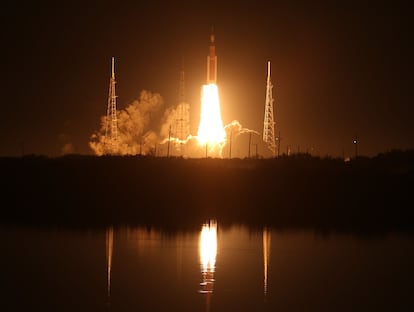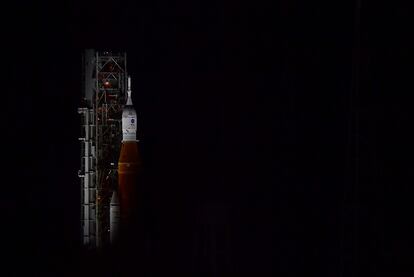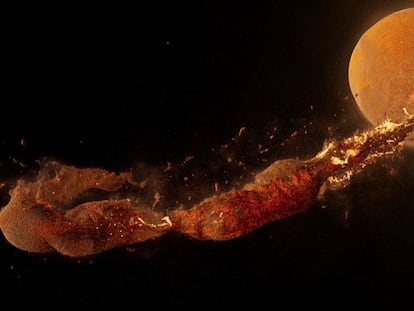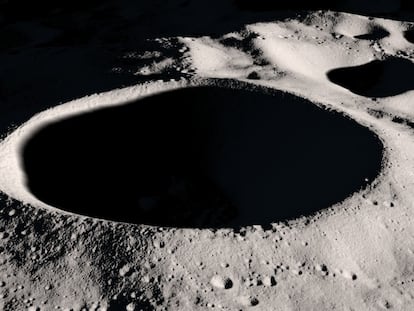Inside NASA’s Artemis mission: Three mannequins, 25 days and a Greek goddess replica
The new, joint US-EU space program is going back to the Moon

On November 16, after months of delays, the US National Aeronautics and Space Administration (NASA) and its partners successfully launched the first spaceflight of the ambitious Artemis program, a robotic and human exploration program to reestablish a human presence on the Moon. Here are the mission highlights.
Was this the first launch attempt?
No, the first launch attempt was scheduled for August 29, but was called off because of leaks during the fueling process. Delays and postponements are a typical part of every space launch, especially because each one now costs about $4 billion. The problem was not resolved quickly, so the launch was postponed to September 3, and then pushed back to the end of September. The third and fourth launch dates were also scratched due to nearby hurricanes and tropical storms.
Is there a crew on this first mission?
There are no astronauts on board, but the Orion capsule has three astronaut-like mannequins equipped with sensors and an odd assortment of items contributed by the public. For example, it carries seeds that will be planted in various parks upon return; a 3D-printed replica of a statue of the Greek goddess Artemis; a still photo from A Trip to the Moon, a film by George Méliés; and a pebble from a Dead Sea beach. Other items on board include a stuffed Snoopy dog in an astronaut suit, along with the pen used by Charles Schulz to draw the Snoopy comics; a stuffed Shaun the Sheep in an ESA flight uniform; and some Lego toys. There are also dozens of flags, emblems, badges and 245 silver pins with Snoopy images destined to become collectors’ items. The historical items on the Orion include an engine screw from the Apollo 11 rocket that was found on the ocean floor in 2015, and a piece of Moon rock collected by Neil Armstrong and Buzz Aldrin during that first Moon landing.
Is the new Artemis Space Launch System (SLS) the most powerful rocket ever made?
Yes, but not by much. It provides slightly more thrust during liftoff than the Saturn V did 50 years ago, but 75% of that comes from two huge side boosters, a design pioneered by the Space Shuttle program. It also uses four repurposed engines from the Space Shuttle program, considered revolutionary technology at the time because of the high energy output of the liquid hydrogen-oxygen fuel mix. The first stage of the Saturn V used five kerosene-burning engines and could launch just over 43 tons into translunar orbit, while the Apollo launcher used three stages to put 27 tons into translunar orbit.
What will be accomplished during this first mission?
It’s a dress rehearsal to test every part of the spacecraft in the most realistic conditions possible. It won’t carry any people but will perform almost every maneuver needed for a manned trip to the Moon, except for a landing.

How long is the mission?
Approximately 90 minutes after liftoff, the rocket’s upper stage propelled the Orion spacecraft out of the Earth’s orbit and set it on course for a 25-day flight that will take it close to the lunar surface. It will then sail more than 40,000 miles (65,000 kilometers) past the Moon before returning to Earth. The capsule will splash down in the Pacific Ocean on December 11.
What’s next for the Artemis program?
If everything goes smoothly, Artemis II will replicate the first mission in 2024, but this time it will be crewed by human astronauts. After that, a Moon landing will be attempted in 2025 by a crew that includes a woman and a person of color, according to NASA.
Why do the Artemis missions take longer than the Apollo missions?
Even though the SLS rocket is the most powerful ever launched by NASA, the current design isn’t strong enough to carry the heavy Artemis payload on its own. It has the same type of second stage used by other rockets with less thrust. And it only has one engine, the ICPS – the “I” stands for “Interim.” The final SLS design will have four engines and is still being developed.
What’s so special about the lunar orbit?
It’s classified as a “retrograde and distant” orbit. Retrograde refers to the fact that it rotates in the opposite direction of the Moon’s orbit around the Earth. This is nothing new – the Apollo spacecraft also did this. Distant refers to the high flight altitude. When it passes by the Moon, Artemis will only be about 60 miles (100 kilometers) above the surface, which is similar to Apollo. But then it will travel a nearly circular route at an altitude of 31,000 miles (50,000 kilometers), consuming as little fuel as possible.
Why is the trajectory so distant?
It’s not the same type of orbit adopted by space missions 50 years ago. It exploits the interaction of the Earth and Moon’s gravity and Lagrangian equilibrium points (points of equilibrium for small-mass objects under the influence of two massive orbiting bodies). Entering this orbit requires very little energy, much less than that used by the Apollo capsules to slow down and get drawn into the Moon’s orbit. The Apollo capsules would fully deplete its nine tons of fuel to brake on arrival at the Moon, and to head back to Earth. The Orion (the Artemis capsule) conserves fuel by traveling at half the speed of the Apollo capsules, so almost no braking is needed.
How will these new spacecraft get to the Moon?
By taking advantage of the special, fuel-efficient orbit being tested by Artemis I. The Artemis II will carry a crew and follow a figure-8 trajectory that turns around as it passes by the far side of the Moon, but without braking. The first Moon landing is planned for Artemis III, which will also travel a fuel-efficient trajectory that resembles a very elongated ellipse over the lunar poles. It’s called a “near-rectilinear halo orbit” and is in the group of stable curves that exploit the Earth-Moon equilibrium points. Calculating these orbits is very complex and was not even attempted until the 1970s, when sufficiently powerful computers and numerical simulation techniques became available.
What about a Moon landing?
The Orion capsules are orbital and cannot land. That will be accomplished by a new vehicle being built by Elon Musk’s SpaceX under contract to NASA. It’s a huge spacecraft based on the SpaceX Starship design for Mars exploration. It is not yet ready for flight.
Do we know where it will land on the Moon?
Yes and no. NASA has chosen 13 possible landing sites at the lunar south pole. One of these will be the place where the first woman may set foot on the Moon. Now the scientists and experts have to figure out the most suitable location.
Is the plan to establish a human presence on the Moon?
A draft NASA paper outlines plans for the Artemis IV mission to begin construction of a space station that would orbit the Moon, and which would require substantial European collaboration. This would happen between 2027 and 2029 at best, and would require at least two or three more flights. NASA is planning five more Artemis missions over the next 10 years that would carry building materials to the Moon for a small, permanent base. The last flight currently planned for the program is Artemis IX, scheduled for 2034.
What other countries are in the space race to the Moon?
Just like the first space race 50 years ago, the world’s superpowers – the US, Europe, China and Russia – want to flex their technological muscle, explore the Moon’s mineral resources, and perhaps establish a waystation to the ultimate goal: Mars. But a few new countries are also jumping in. South Korea’s Danuri probe was launched on August 4 and will enter lunar orbit in December. Other missions to the Moon from India, Japan, the United Arab Emirates and China are also planned.
Is this the first step towards Mars?
NASA, the lead agency in the Artemis program, has indeed touted it as a warm-up for the ultimate goal of setting foot on Mars.
Tu suscripción se está usando en otro dispositivo
¿Quieres añadir otro usuario a tu suscripción?
Si continúas leyendo en este dispositivo, no se podrá leer en el otro.
FlechaTu suscripción se está usando en otro dispositivo y solo puedes acceder a EL PAÍS desde un dispositivo a la vez.
Si quieres compartir tu cuenta, cambia tu suscripción a la modalidad Premium, así podrás añadir otro usuario. Cada uno accederá con su propia cuenta de email, lo que os permitirá personalizar vuestra experiencia en EL PAÍS.
¿Tienes una suscripción de empresa? Accede aquí para contratar más cuentas.
En el caso de no saber quién está usando tu cuenta, te recomendamos cambiar tu contraseña aquí.
Si decides continuar compartiendo tu cuenta, este mensaje se mostrará en tu dispositivo y en el de la otra persona que está usando tu cuenta de forma indefinida, afectando a tu experiencia de lectura. Puedes consultar aquí los términos y condiciones de la suscripción digital.
More information
Últimas noticias
Sinaloa Cartel war is taking its toll on Los Chapitos
Venezuela hardens its ‘revolutionary state’ project amid pressure from Trump
Sydney Sweeney, the actress praised by Trump: ‘Women are up against what society wants them to be’
The Bolsonaro surname: An advantage or liability in Brazil’s 2026 presidential elections?
Most viewed
- Reinhard Genzel, Nobel laureate in physics: ‘One-minute videos will never give you the truth’
- Pablo Escobar’s hippos: A serious environmental problem, 40 years on
- Charles Dubouloz, mountaineering star, retires at 36 with a farewell tour inspired by Walter Bonatti
- Why we lost the habit of sleeping in two segments and how that changed our sense of time
- The fall of a prolific science journal exposes the billion-dollar profits of scientific publishing











































